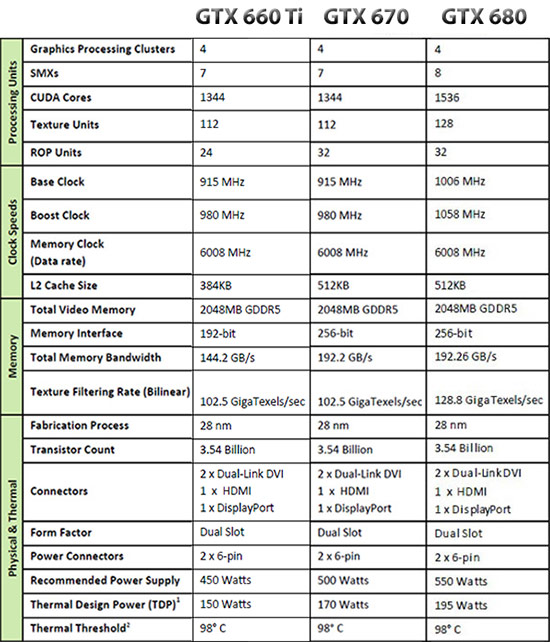NVIDIA GeForce GTX 660 Ti Video Card Review w/ ASUS, EVGA & MSI
Final Thoughts & Conclusion
General Thoughts on the GeForce GTX 660 Ti:
The new NVIDIA GeForce GTX 660 Ti video cards are built using the same GK104 GPU used in the GeForce GTX 690/680/670 products. The only difference is that the GeForce GTX 660 Ti has a few things disabled. For example it has eight fewer raster operation units (often called the ROP), a reduced L2 cache size of 384KB and a narrower memory bus width of just 192-bits. The cache is tied to the memory controller on the Kepler GPU architecture, so when you disable a memory controller, you disable its L2 cache and decrease the available bus. That is all the cutting and disabling that NVIDIA did though, so luckily the GeForce GTX 660 Ti packs the same number of CUDA Cores as the GeForce GTX 670 and even has the same clock speeds on the GPU and 2GB of GDDR5 memory. The good news is that power consumption is down thanks to the lower 150W TDP and just a 450 Watt power supply is needed to properly run the GeForce GTX 660 Ti. Some companies like ASUS suggest running a 550 Watt power supply for their overclocked cards, but that a bit excessive from our point of view.

The NVIDIA GeForce GTX 660 Ti graphics card was designed to push the envelope when it comes to both performance and value. NVIDIA needed this card to land right in the middle of the sweet spot for gamers and enthusiasts. By utilizing yet another toned down version of the Kepler GK104 GPU they were able to do just that.

The lowest cost NVIDIA GeForce GTX 670 on Newegg is the MSI N670GTX-PM2D2GD5/OC, which is $374 shipped after a $25 rebate. This GeForce GTX670 card is factory overclocked with a base clock of 965MHz and a boost clock of 1045MHz. Not a bad deal for a GeForce GTX 670, but the GeForce GTX660 Ti is a game changer. The NVIDIA SRP on the GeForce GTX 660 Ti is $300, so it is $74 less than the least costly GeForce GTX 670 video card. This makes the NVIDIA GeForce GTX 660 Ti roughly 20% less and as you saw in the performance benchmarks it is a often beats the GeForce GTX 670 at a screen resolution of 1920×1080.
The direct competition for this card is the AMD Radeon HD 7950 and the lowest priced card on that side of the fence is the XFX Double D Radeon HD 7950, which is available for $319.99 with $7.87 shipping after a $30 rebate. This makes the AMD Radeon HD 7950 about $30 more than the base version of the NVIDIA GeForce GTX 660 Ti and as you saw it was able to hold it’s own in the games, but was a tad slower in the synthetic benchmarks. AMD recently released a vBIOS update for the Radeon HD 7950 series that increases the cards GPU clock from 800MHz to 925MHz and includes boost clocks in hopes to foil NVIDIA’s launch today. We tested with the AMD Radeon HD 7950 with the new and free vBIOS update and the results speak for themselves. AMD is not going to be releasing a Radeon HD 7950 GHz edition card nor will they be hosting the GHz BIOS themselves, but they released the file for sites to host.
Most gamers today game on a 1080P monitor, so this is the sweet spot and the GeForce GTX 660 Ti is now the card to have at that price.
Thoughts on the GeForce GTX 660 Ti AIB Cards:
Thanks to the support of ASUS, EVGA and MSI we were able to look at several NVIDIA GeForce GTX 660 Ti solutions. Each card was different, so it was good to get a feel for what was coming to the mainstream market. Since all the cards are using the same core and memory, the true difference between cards is in the clock speeds, GPU cooler, PCB design and components. At the end of the day when choosing what GeForce GTX 660 Ti video card to get it is personal opinion. All three of the cards today has excellent performance in today’s games and represent the best value in gaming at this particular moment.
When it comes to cooling the ASUS GeForce GTX 660 Ti DirectCU II TOP Edition card performed the best at load and was the quietest of the group. That said, you need to keep in mind that all three cards were running different GPU clock speeds. It is hard to declare a winner when all the cards have dynamic clock speeds, but if you go by noise and temperature results the ASUS card leads the way. One other thing that is worth pointing out is that the ASUS and MSI cards use a GPU cooler that dump some heat back into the system, whereas the EVGA GeForce GTX 660 Ti Superclocked card exhausts it outside of the case.
Overclocking performance was impressive on all of the cards. The base clock speed of the NVIDIA GeForce GTX 660 Ti is 980MHz and we were able to get the base clock all the way up to around 1100MHz on all three cards with no voltage increase at all. The 2GB of GDDR5 memory was also very overclocking friendly as we were able to go from 6008MHz to 7008MHz on each card with no issues at all.
We have no issues recommended all three of these video cards as all of them are impressive and cost between $310 and $325. For a limited time, gamers who purchase a NVIDIA GeForce GTX 660 Ti GPU from a participating retailer or e-tailer will receive a voucher for a free copy of Gearbox Software’s Borderlands 2 to help sweeten the deal.

Legit Bottom Line: With a lower entry price and performance similar to much more expensive cards, the GeForce GTX 660 Ti is set to shake up the graphics card market. Combined with ample overclocking headroom, the GeForce GTX 660 Ti is absolutely the sweet spot for performance per dollar.

Comments are closed.